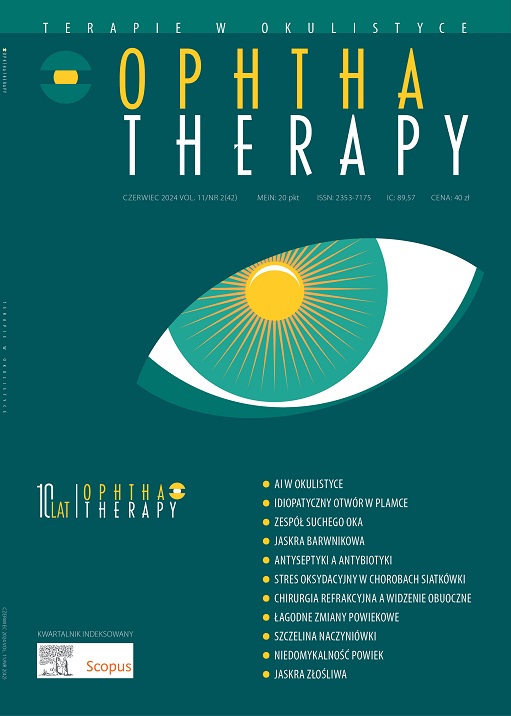Management strategies in benign eyelid lesions Artykuł przeglądowy
##plugins.themes.bootstrap3.article.main##
Abstrakt
Eyelid tumors are a common discovery during an ophthalmological or dermatological examination. According to available knowledge, they constitute about 5–10% of skin tumors. The majority of them are benign and can be classified as inflammatory, infectious, traumatic or neoplastic lesions. Depending on the lesion type, there are different approaches to management that include: observation, topical application of steroids or antibiotics, injection of steroids, application of warm compresses, biopsy, excision, curettage, various types of laser therapy or plasma-based therapies, cryosurgery and electrocautery. Malignant eyelid tumors are not rare, therefore, an accurate diagnosis is crucial to provide best suited type of treatment. In many cases, an experienced physician is able to distinguish a benign lesion basing on clinical examination, however, it is often difficult to differentiate benign tumors from malignant and premalignant lesions. In case of any uncertainty, a biopsy followed by histopathological examination should always be taken into consideration.
Pobrania
##plugins.themes.bootstrap3.article.details##

Utwór dostępny jest na licencji Creative Commons Uznanie autorstwa – Użycie niekomercyjne – Bez utworów zależnych 4.0 Międzynarodowe.
Copyright: © Medical Education sp. z o.o. License allowing third parties to copy and redistribute the material in any medium or format and to remix, transform, and build upon the material, provided the original work is properly cited and states its license.
Address reprint requests to: Medical Education, Marcin Kuźma (marcin.kuzma@mededu.pl)
Bibliografia
2. Sendul SY, Akpolat C, Yilmaz Z et al. Clinical and pathological diagnosis and comparison of benign and malignant eyelid tumors. J Fr Ophtalmol. 2021; 44(4): 537-43. http://doi.org/10.1016/j.jfo.2020.07.019.
3. Stokkermans TJ, Prendes M. Benign Eyelid Lesions. In: StatPearls. Treasure Island (FL): StatPearls Publishing, 2023.
4. Tesluk GC. Eyelid lesions: incidence and comparison of benign and malignant lesions. Ann Ophthalmol. 1985; 17(11): 704-7.
5. Deprez M, Uffer S. Clinicopathological features of eyelid skin tumors. A retrospective study of 5504 cases and review of literature. Am J Dermatopathol. 2009; 31(3): 256-62. http://doi.org/10.1097/DAD.0b013e3181961861.
6. Yu SS, Zhao Y, Zhao H et al. A retrospective study of 2228 cases with eyelid tumors. Int J Ophthalmol. 2018; 11(11): 1835-41. http://doi.org/10.18240/ijo.2018.11.16.
7. Huang YY, Liang WY, Tsai CC et al. Comparison of the Clinical Characteristics and Outcome of Benign and Malignant Eyelid Tumors: An Analysis of 4521 Eyelid Tumors in a Tertiary Medical Center. Biomed Res Int. 2015; 2015: 453091. http://doi.org/10.1155/2015/453091.
8. Kalemaki MS, Karantanas AH, Exarchos D et al. PET/CT and PET/MRI in ophthalmic oncology (Review). Int J Oncol. 2020; 56(2): 417-29.
9. Alexander JL, Wei L, Palmer J et al. A systematic review of ultrasound biomicroscopy use in pediatric ophthalmology. Eye (Lond). 2021; 35(1): 265-76.
10. Ferrari B, Salgarelli AC, Mandel VD et al. Non-melanoma skin cancer of the head and neck: the aid of reflectance confocal microscopy for the accurate diagnosis and management. G Ital Dermatol Venereol. 2017; 152(2): 169-77. http://doi.org/10.23736/S0392-0488.16.05316-5.
11. Zimmerman EE, Crawford P. Cutaneous cryosurgery. Am Fam Physician. 2012; 86(12): 1118-24.
12. Thai KE, Sinclair RD. Cryosurgery of benign skin lesions. Australas J Dermatol. 1999; 40(4): 175-84. http://doi.org/10.1046/j.1440-0960.1999.00356.x .
13. Clebak KT, Mendez-Miller M, Croad J. Cutaneous Cryosurgery for Common Skin Conditions. Am Fam Physician. 2020; 101(7): 399-406.
14. Gage AA, Baust J. Mechanisms of tissue injury in cryosurgery. Cryobiology. 1998; 37(3): 171-86. http://doi.org/10.1006/cryo.1998.2115.
15. Yates B, Que SK, D’Souza L et al. Laser treatment of periocular skin conditions. Clin Dermatol. 2015; 33(2): 197-206. http://doi.org/10.1016/j.clindermatol.2014.10.011.
16. Brauer JA, Geronemus RG. Laser treatment in the management of infantile hemangiomas and capillary vascular malformations. Tech Vasc Interv Radiol. 2013; 16(1): 51-4. http://doi.org/10.1053/j.tvir.2013.01.007.
17. Cheles D. Treatment of xanthelasma with fractional plasma. Esperienze Dermatol. 2021; 23: 1-6. http://doi.org/10.23736/s1128- 9155.21.00513-6.
18. Hirst AM, Frame FM, Maitland NJ et al. Low temperature plasma: a novel focal therapy for localized prostate cancer? Biomed Res Int. 2014; 2014: 878319. http://doi.org/10.1155/2014/878319.

